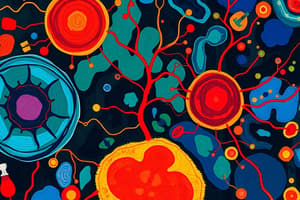Podcast
Questions and Answers
Which type of signalling targets the cell itself?
Which type of signalling targets the cell itself?
- Autocrine (correct)
- Endocrine
- Paracrine
What is the role of a ligand in cell signalling?
What is the role of a ligand in cell signalling?
- It transmits signals inside the cell.
- It amplifies the cellular response.
- It binds to receptors to initiate signalling. (correct)
What is a Receptor Tyrosine Kinase (RTK) activated by?
What is a Receptor Tyrosine Kinase (RTK) activated by?
Ligands
What does cAMP function as in cell signalling?
What does cAMP function as in cell signalling?
Phosphorylation refers to the addition of a phosphate group to proteins.
Phosphorylation refers to the addition of a phosphate group to proteins.
Amplification in cell signalling means one signal molecule leads to no response inside the cell.
Amplification in cell signalling means one signal molecule leads to no response inside the cell.
What is the function of kinases in cell signalling?
What is the function of kinases in cell signalling?
Which of the following describes autocrine signalling?
Which of the following describes autocrine signalling?
What is the end result of the signalling process?
What is the end result of the signalling process?
Study Notes
Types of Signalling
- Autocrine Signalling: Cells signal to themselves; important in self-regulation and feedback.
- Paracrine Signalling: Localized signaling where cells communicate with neighboring cells; crucial for tissue response.
- Endocrine Signalling: Long-range signaling via hormones in the bloodstream; affects distant targets throughout the body.
Cell Signalling Process
- Reception: Ligands attach to specific cell surface receptors, initiating the signalling process (lock-and-key model).
- Transduction: The signal is transmitted within the cell through pathways, such as phosphorylation and second messengers.
- Response: Ultimately leads to changes in gene expression or alterations in ion flow, affecting cellular functions.
Key Components
- Ligand: Molecule that binds to a receptor to kickstart signaling.
- Receptor Tyrosine Kinase (RTK): A receptor activated by ligands which triggers multiple signaling pathways.
- G-Protein-Coupled Receptor (GPCR): Activates G-proteins to regulate various downstream signaling events.
- Mitogen-activated Protein Kinase (MAPK): Amplifies signaling for stronger cellular responses.
- Second Messenger (e.g., cAMP): Increases the internal signaling capabilities of the cell.
- Phosphorylation: The addition of phosphate groups to proteins modifies their activity, facilitating intracellular communication.
Proteins and Receptors
- Proteins play critical roles in all levels of the signaling process, especially as receptors located on cell surfaces.
Second Messengers
- Function like internal text messages that distribute the signal within the cell post-receptor engagement, leading to a faster response.
Enzymes and Phosphorylation
- Enzymes, particularly kinases, are pivotal in adding phosphate groups to proteins, often switching them on for function, central to signal transduction.
Amplification
- One signaling molecule can lead to a significant cellular response, akin to a microphone amplifying sound; this occurs through pathways that activate numerous proteins.
Ribosomes
- Serve as the cellular machinery for protein synthesis, interpreting mRNA instructions derived from DNA to create proteins integral to signaling pathways, including GPCR-related proteins.
End of Signalling Process
- Concludes with the transmission of signals to the nucleus, influencing gene expression through binding of proteins like transcription factors to DNA, guiding production of response-specific proteins.
Signal Reception
- Signalling Molecule: Ligand engages with cell surface receptor; adrenaline is a prime example that works with GPCR.
Signal Transduction
- The activated receptor undergoes shape alteration, leading to internal protein activation, including G-proteins which trigger secondary processes.
Second Messenger Activation
- Enzymes such as adenylate cyclase convert signals into second messengers (e.g., cAMP), amplifying the intracellular signal.
Cellular Response
- Kinases get activated through the second messenger pathway, resulting in specific cellular actions, including gene activation and response facilitation.
Studying That Suits You
Use AI to generate personalized quizzes and flashcards to suit your learning preferences.
Description
This quiz explores the different types of cell signalling, including autocrine, paracrine, and endocrine mechanisms. It also covers the processes involved in cell signalling, such as reception, transduction, and response. Test your understanding of how cells communicate and respond to signals!




